Today's Laugh,
Tomorrow's Plum Blossoms
A Very Special Templestay at Jeungsimsa
by Two Refugee Applicants, Ratna and Janak
Text by. Park Hyeon-suk Photo by. Nam Yun-jung
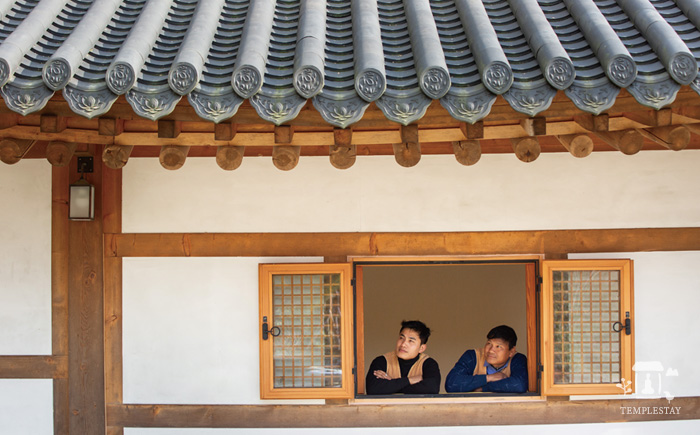
The two men laughed. The laughter bursting from their chest was like the sunlight of
a new spring day on the steps of the main buddha hall of Jeungsimsa Temple. Spring
touches our heart more beautifully because we have endured a harsh winter. The two
men seemed to be going through a long winter of their own, but their laughter seemed
to remind us that spring is just around the corner when the cold reaches its peak.
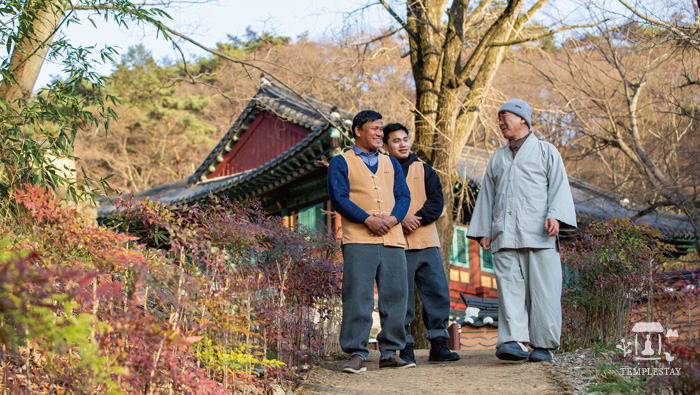
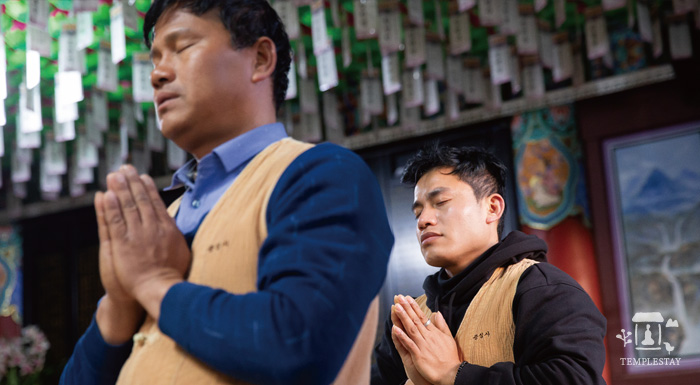
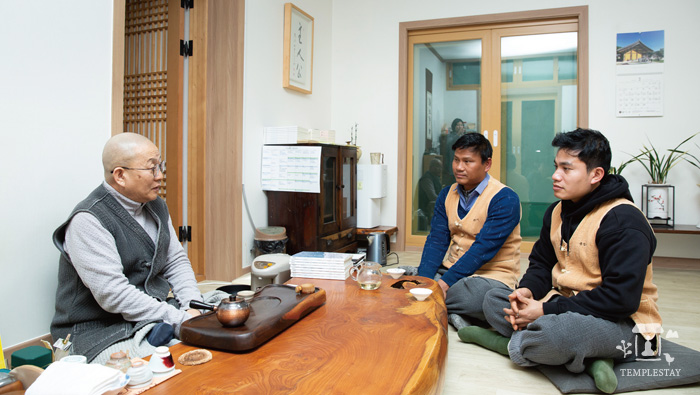
Seen from the vast expanse of the universe, the Earth looks like a tiny, trivial speck, but that does not lessen its significance. Ratna and Janak are members of the Jumma tribe in Bangladesh. Bangladesh has 160 million Bengalis, and the 750,000 Jumma people are an ethnic minority that make up about 0.5% of the total population. When Bangladesh gained independence from Pakistan in 1971, the Jumma people—an indigenous people living in the Chittagong Hill Tracts region—moved to Bangladesh. With most Bengalis believing in Islam, the Bangladesh government suppressed the Buddhist Jumma people.
The Jumma people protested to regain the freedoms they had lost, but it was too overwhelming, and many of them fled to India, Myanmar and other countries around the world. Unable to forget their roots in Chittagong, however, these expatriates are still working to resolve human rights abuses, including being persecuted and massacred by the Bangladesh government. There are about 1 million Jumma people living scattered around the world, of whom 180 live in South Korea.
Since his arrival in Korea in 2008, Ratna Kirti Chakma (44) has been involved in various activities in support of his home country, including serving as president of the Jumma People's Solidarity in Korea. When he first came to Korea, he was a Buddhist monk. He served as a Templestay guiding monk for foreigners, first at Seonghyeolsa Temple in Yeongju and later at Hwagyesa Temple in Seoul. Currently, he is a refugee applicant. In order to make a living, he gave up his ordained status and returned to being a lay Buddhist, but his life in Korea is still precarious due to restrictions on employment. Nevertheless, in his warm interactions with members of the Jumma People's Solidarity in Korea, he sometimes strengthens his faith through Templestay experiences and tries to live life to the fullest while appreciating small moments of happiness.
On the first weekend of March, when there was the first hint of spring in the air, he asked Janak Dewan (30)—a Jumma man he considered a younger brother—to accompany him on a Templestay at Jeungsimsa Temple. Being in a hurry from early in the morning for their first outing in a long time, they left Gimpo—where many Jumma people live—and headed to Jeungsimsa Temple in Gwangju, Jeollanam-do. Both men said it was their first time visiting Jeungsimsa Temple, although Ratna has been in Korea for 15 years while Janak for 4 years.
A Prostration to Myself at Jeungsimsa’s Main Buddha Hall
“I am not afraid of death.”
This was Janak's unexpected answer to my question about what his life was like in Korea so far, a question I asked during a short break after we arrived in Gwangju. His words left a strong lingering impact on me. A smile spread across Janak’s face as he gave this confident answer. Ratna said he felt the warmth of the Korean people while receiving much help from them, and upon hearing Janak's answer, he broke into a big smile. I asked why, wondering if it was something felt heart to heart between the two of them.
Janak said, “I am not afraid of a world I have never been to or of what I do not know. This includes Korea and the unknown realm of death. It is because I have Buddhism that answers all questions and is the key to happiness. As a Buddhist, I am grateful and happy. Korea is an unfamiliar place, but I am happy here.”
Although his Korean was not so good, his warm and accepting attitude toward life was fully reflected in his smile.
Janak, who majored in economics at India's prestigious Kolkata University, said he—like Ratna— wanted to help Jumma children living in Korea despite his precarious life as a refugee, adding that he considered Ratna “a good person.”
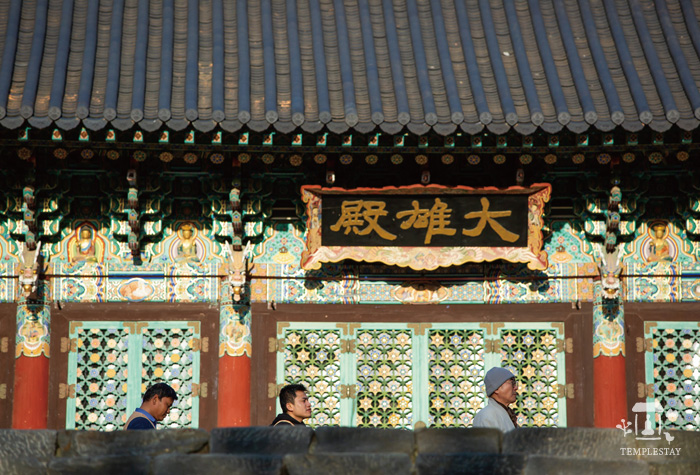
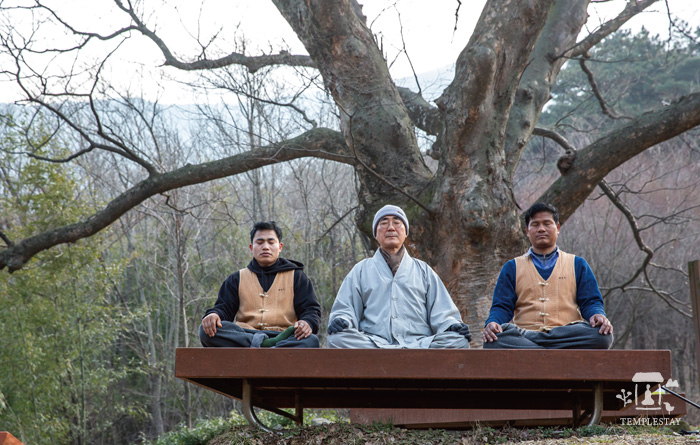
After traveling for about 20 minutes from Gwangju’s KTX Songjeong Station, we finally arrived at Jeungsimsa Temple. It was the last cold snap in Seoul and sleet was falling, but the trees throughout the temple were pale green with buds sprouting. The daffodils and magnolias were just beginning to bud, and the cornelian cherry and plum blossoms were shining bright yellow and white. Ratna saw some broadleaf bamboo, which is green all year round. This delighted him, and he remarked that there are many similar types of bamboo in Chittagong.
Our guide arrived and introduced himself. “Welcome. I am Deokseong, Jeungsimsa's Templestay guiding monk. Now, please look around. The mountain surrounding Jeungsimsa Temple is the renowned Mt. Mudeungsan. Before embarking on our temple tour, we will take some deep breaths as Mt. Mudeungsan does. Breathe as deeply as you can and feel your breaths going in and out. Focus on your breathing, something most people are unaware of. Feel the peace and beauty of the moment.”
Ven. Deokseong encouraged them to take some deep breaths before starting the tour. After refreshing their body and mind through breathing, they—along with other Korean participants who became their dharma brothers and sisters for two days—toured some of the major structures of the temple, including Daeungjeon, Birojeon, Obaekjeon, and the three-story stone pagoda, studying their significance and history. Daeungjeon, the main buddha hall, enshrines Shakyamuni Buddha, the historic Buddha who attained enlightenment. Birojeon Hall enshrines Vairocana Buddha, the embodiment of all truth, and Obaekjeon Hall enshrines 500 arhats, Buddhist sages of the past. The temple’s three-story stone pagoda enshrines cremains of the Buddha. All of these felt solid and permanent, like “a pillar to lean on.” No matter how beautiful a place is, what's the point if it is empty of people and meaning? The reason one's hometown is beautiful is because the people one misses reside there.
As the sun began to set, we headed to Daeungjeon Hall to ring the temple bell and offer the evening Buddhist ceremony. Ratna entered Daeungjeon Hall first and saw Janak entering after him. With his characteristic calm smile, Ratna left the hall with Janak, and they came back in together.
Ratna explained to Janak, “When you cross the threshold of Daeungjeon Hall, you first place your palms together and offer a half bow. You don't just come in. When you leave after the Buddhist ceremony, instead of rushing out, offer a half bow like this at the door. Now, let’s offer a half bow together and go back in.” It was endearing to see Ratna carefully guiding Janak, who was unfamiliar with temple etiquette. Before the Buddhist ceremony, Ven. Deokseong offered them these encouraging words of advice: “Usually we offer prostrations as a ritual of respect to the Buddha, but this time when you prostrate yourself, try thinking of it as a prostration to yourself. Only when you know how to respect yourself, can you respect others.”
The Abbot's Empathy Nurtures Hope
After the dinner offering, Ven. Junghyeon, abbot of Jeungsimsa Temple, welcomed Ratna and Janak by serving tea.
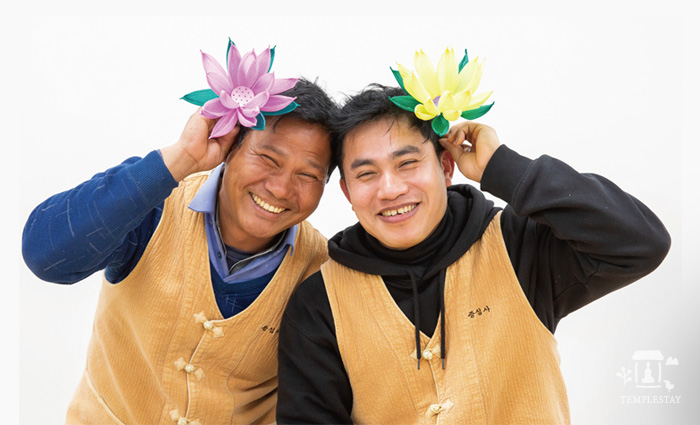

He said, “I recently visited Taiwan. I stopped by a museum there and wanted to take a closer look, so I asked my group to go on without me. Soon it was time for the museum to close, but when I went outside, I found that securing transportation wasn't that easy. It was quite frustrating to be alone in a place where no one spoke Korean. After some difficulty I returned to my accommodations. Even though I was only there a short time, I found the language barrier very frustrating, so I can just imagine how difficult it is for you to live as a refugee in an unfamiliar country.” Ven.
Deokseong’s story touched the hearts of Ratna and Janak, and I realized how warm and powerful empathy can be.
Ven. Junghyeon has been taking the lead in putting Buddha-dharma into action by holding a “Monk's Pizza Shop” event every month with the Compassion in Action Association, a volunteer group of Buddhists in the Gwangju area. This group helps local youth and carries out mutual support activities with local foreign workers. Ven. Deokseong asked Ratna and Janak what difficulties they had encountered. Ratna replied, “It is unfortunate that second-generation Jumma children have few opportunities to experience Buddhist culture,” to which Ven. Deokseong said, “A Templestay program could be a good opportunity.
We will always keep our temple gate open for you.
Please visit us anytime with your Jumma children!” Just as small ripples on a calm lake eventually spread to the entire lake, the monk's empathy became palpable, filling the quiet air of the tea room with hope.
Ratna and Janak smiled hopefully as they left the tea room and walked through the dark temple compound toward their room. Ratna suggested, “The Buddha's teachings are not just something to believe in. We should go beyond that and learn and practice his teachings!" His words instantly engraved themselves in my mind.
On the Mountain of Complete Equality
After attending the early morning ceremony at 4 a.m., the next day, Ratna, Janak, and Ven, Deokseong climbed Mt. Mudeungsan, upon which Jeungsimsa Temple nestles. The word “mudeung (lit. peerless)” in “Mt. Mudeungsan” means there is no comparison, implying “complete equality.” The word “mudeung (無等)” also refers to the Buddhist concepts of “unequalled [無等等]” and “incomparable [無有等等].” The term “incomparably high and unable to be ranked” also refers to the Buddha, the supreme and unrivaled teacher. At the entrance to Mt. Mudeungsan—which many consider the mother mountain of Gwangju due to its generous and warm embrace—we came across a local village’s 500-year-old “guardian tree” (Dangsan tree) and spent time meditating under it with Ven. Deokseong. The fresh morning breeze in the shade of the Dangsan tree seemed to halt both footsteps and any stream of consciousness, and the songs of the mountain birds wafting on the breeze I took to be a teaching telling me to “keep flowing, do not stagnate.”
Now, in the season when flowers bloom, Ratna and Janak descended the mountain and returned to the innocence of childhood, making a lotus out of hanji, traditional Korean paper. Templestay team leader Choe Jin-su—who was teaching us how to make paper flowers—said, “It’s okay if the petals are not arranged neatly. If you actually look at a lotus flower, some petals are almost stuck together.” Still, Ratna was embarrassed, saying that his petals were too jagged while Janak just seemed to be having fun.
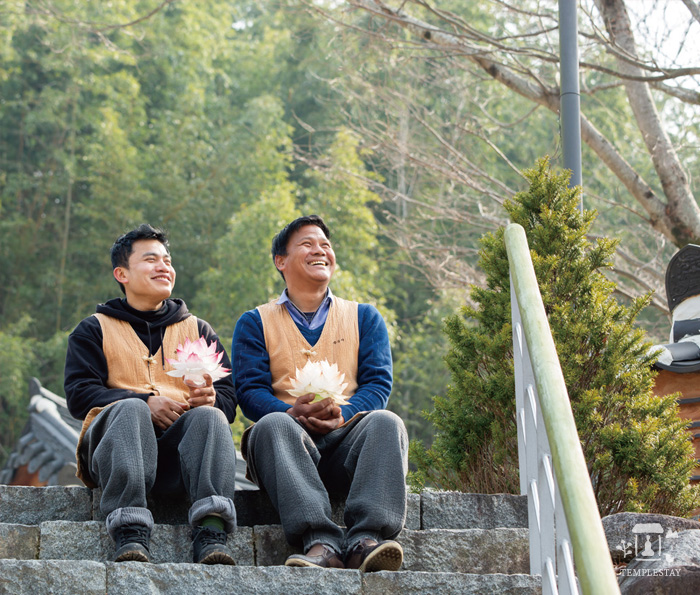
Like Plum Blossoms that Bloom in Spring Even in the Cold
As Ratna and Janak finished making their paper lotuses, the plum blossoms were in full bloom outside the window. The plum blossom is said to be the first heralder of spring. It is a brave flower of wisdom that senses the slightest stirrings of spring even when other flowers hesitate to bloom and when the cold makes one button up their jacket. Aren't blooming plum blossoms a small but clear sign of hope? Looking at the plum blossoms, Ratna and Janak revealed their characteristic soft smiles.
A refugee applicant is someone waiting for a door to open, but they don't have the authority to open it. Only when someone on the other side unlocks it, can they enter. I couldn't even guess what it was like for them trying to get by while waiting so long for the door to open. However, they were undoubtedly people with optimism and a glimmer of hope.
After the Templestay, Janak walked around Jeungsimsa Temple taking photos to remember his experience there, proclaiming, “I am very happy today!” Ratna, who had brought him to Jeungsimsa Temple, smiled with pride. Even if your life is difficult 90% of the time, if you have the wisdom and courage to spend 10% of today laughing, you will be the first to experience happiness, like Ratna and Janak.
Park Hyeon-suk is a freelance writer and interviewer. She loves Korea's traditional culture and nature, dreams of “ancient futures” (a concept proposed by Helena Norberg-Hodge) and pursuing sustainable values. She has met with individuals who embody intangible cultural assets and who pass down traditions from generation to generation. She has promoted Korean culture through the quarterly magazines Hanok and Koreana.
Jeungsimsa Temple
+82-62-226-0108
https://jeungsimsa.org





